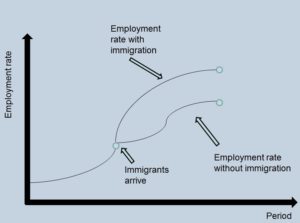The Royal Swedish Academy of Sciences has announced David Card as one the winners of the 2021 Nobel Prize in economics. One of Card’s main academic contributions is to our understanding of the labour market impacts of immigration and no other Nobel award has come closer to my own research or to the content that I teach to our students in the MSc in Migration Studies.
To understand Card’s contribution to our understanding of the labour market impacts of immigration, it is important to illustrate the problem faced by researchers in this field. As shown in the figure below, imagine that you want to estimate the impact of immigration on the employment rate of a given city. An easy way to do this would be to compare the employment rate before and after the arrival of migrants to this location.
However, this approach has obvious limitations. First, it is possible that many other things are happening in this location. Perhaps there is a national economic downturn, or a boom in the construction sector. Second, we would expect migrants to locate in places that they expect to do better in the future. What we really want is to hold these other things constant and to compare the employment rate in that city with a counterfactual employment rate in which the migrants have not arrived to the city. Alas, you can only observe the city with or without migrants.
 In 1990, Card published an influential study in which he explored immigration from Cuba to Miami and proposed a method for dealing with this difficulty. In 1980, the Cuban government opened the door for individuals to leave the country. As a result, an exodus by sea, known as the Mariel boatlift, took place (over 100k migrants left). Half of the Marielitos (as these individuals came to be known) settled in Miami, increasing the city’s labour supply by close to 8%. Most of them did not have a high school diploma and the city’s unemployment rose substantially in a matter of months. This last fact suggests a substantial negative labour market impact.
In 1990, Card published an influential study in which he explored immigration from Cuba to Miami and proposed a method for dealing with this difficulty. In 1980, the Cuban government opened the door for individuals to leave the country. As a result, an exodus by sea, known as the Mariel boatlift, took place (over 100k migrants left). Half of the Marielitos (as these individuals came to be known) settled in Miami, increasing the city’s labour supply by close to 8%. Most of them did not have a high school diploma and the city’s unemployment rose substantially in a matter of months. This last fact suggests a substantial negative labour market impact.
Card suggested that the best approach would be to compare Miami with similar cities in which there were no sudden increases in immigration. After doing this, his main conclusion was that Mariel immigration had no effect on employment outcomes or wages. Card’s study of Mariel immigration has led to multiple follow-up studies and heated debate on the impact of this event on Miami’s labour market.
Another of Card’s key contributions to the study of migration was published in 2001. This study explores the impacts of immigration on labour market outcomes in the United States. However, the contribution of this study is also methodological.
This paper relies on the idea that the lagged geographic distribution of migrants can be used as an exogenous influence on the current geographic distribution. For instance, if many Chinese migrants settled in certain cities in the United States decades ago, we would expect many new Chinese migrants to also settle in those cities. After all, immigration is largely influenced by networks. If we assume that the reasons that led to immigration decades ago are not exerting influence on current decisions, then we have what we call an exogenous instrument that will allow us to estimate the labour market impact of immigration.
Card found that immigration over the 1980s reduced wages and employment rates of lower-skilled US-born residents in key gateway cities by 1 to 3 percentage points, which is a small impact.
The methodology used by Card (2001) to estimate these numbers has also been at the centre of intense academic debate during recent years. However, as was the case with the Mariel boatlift study, the fact that we are still discussing these studies decades later it is a major testament of Card’s legacy to our understanding of the impacts of immigration.
